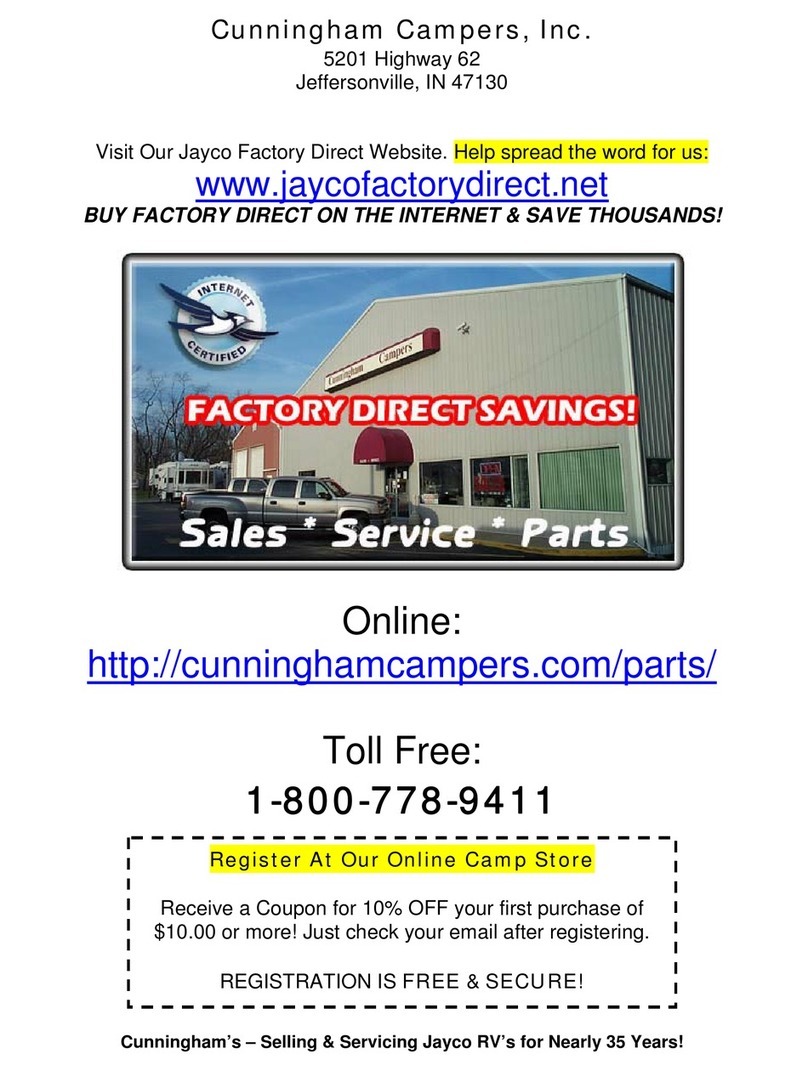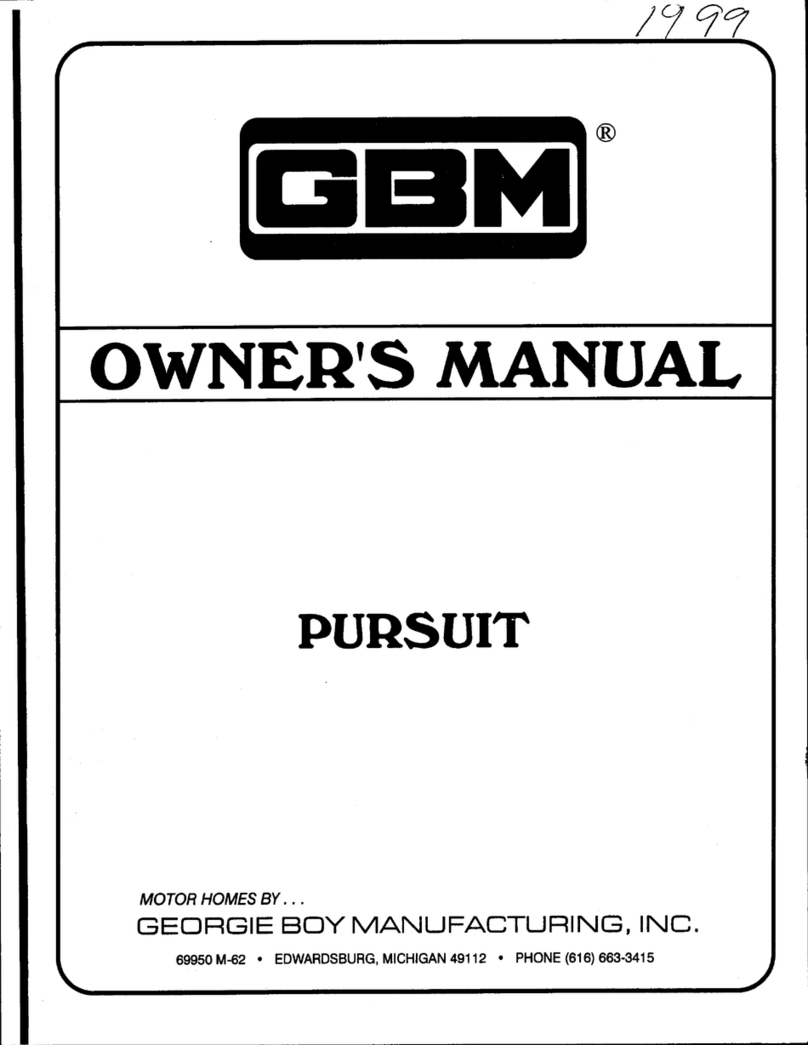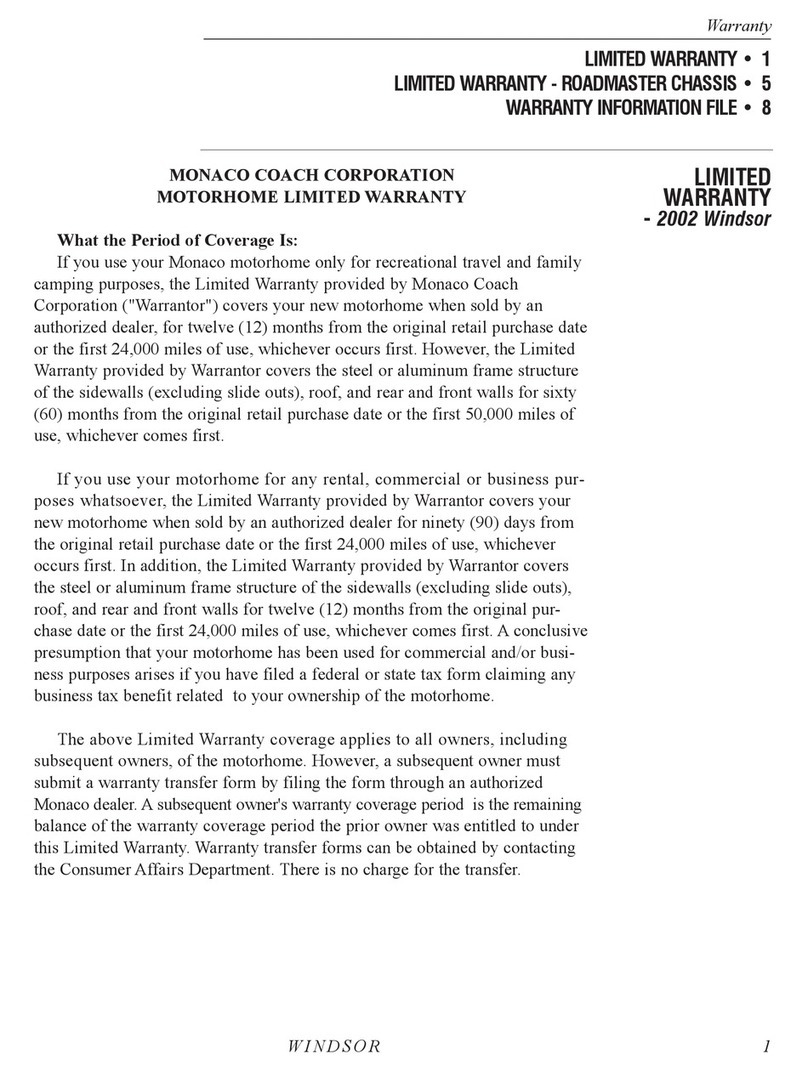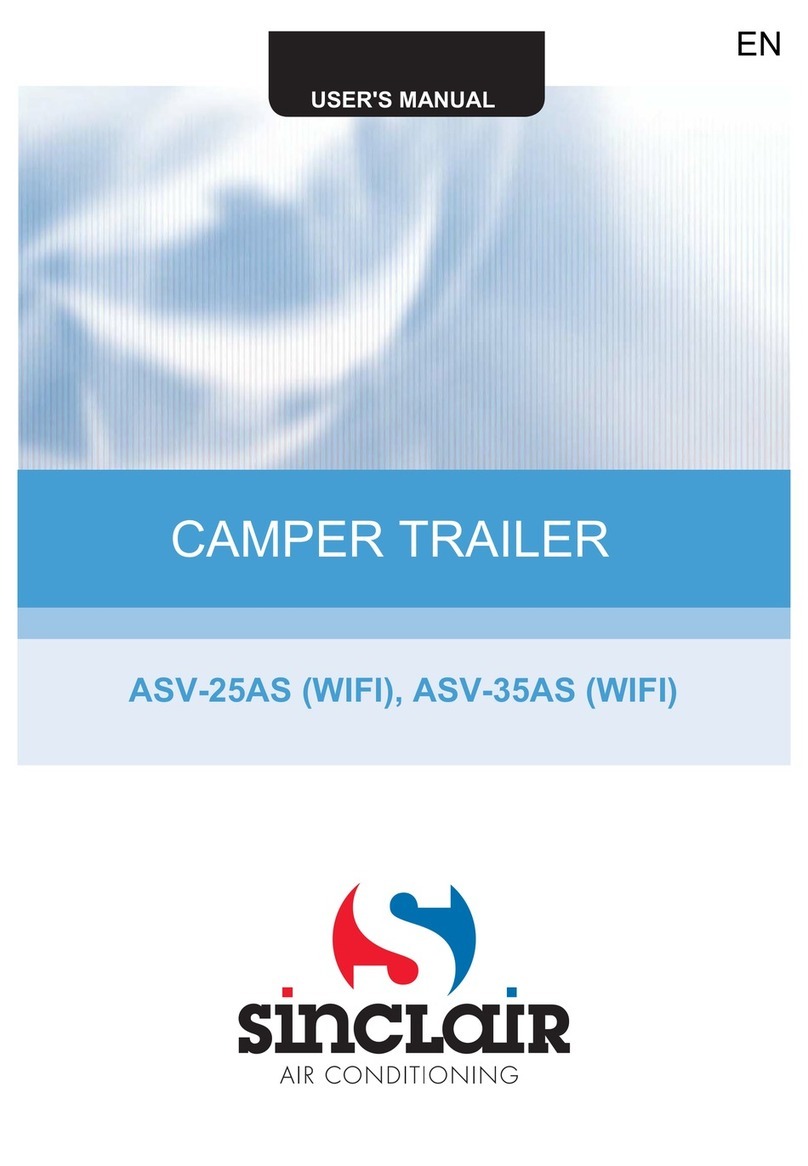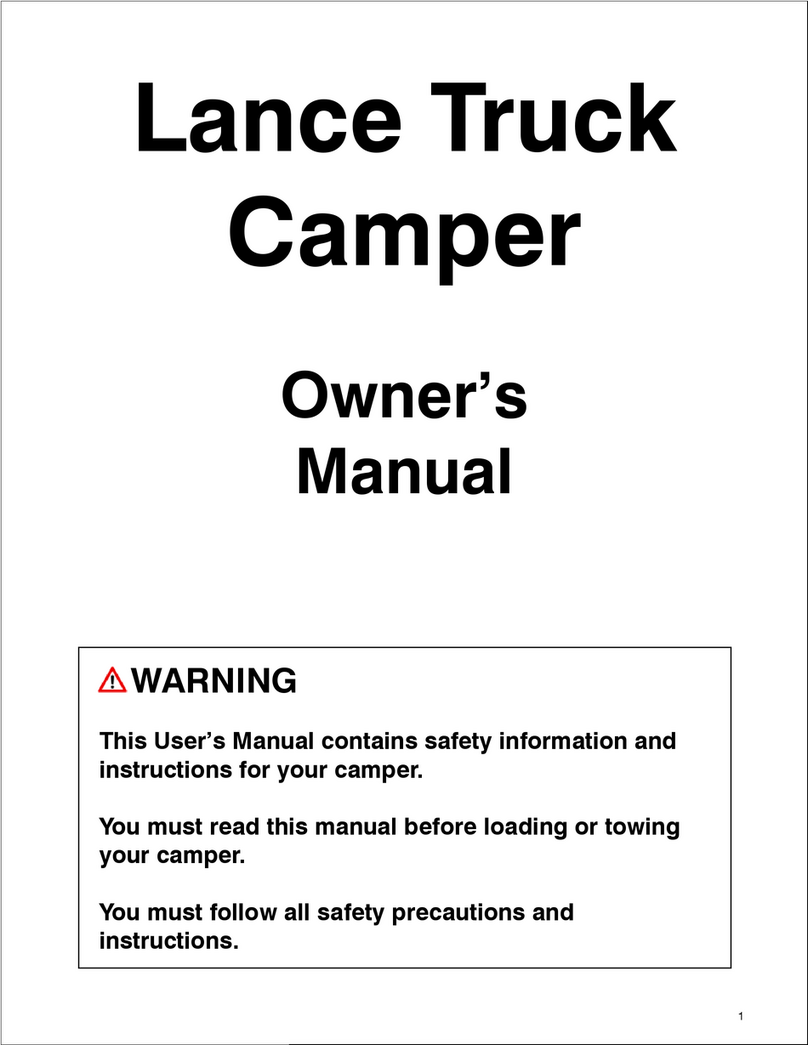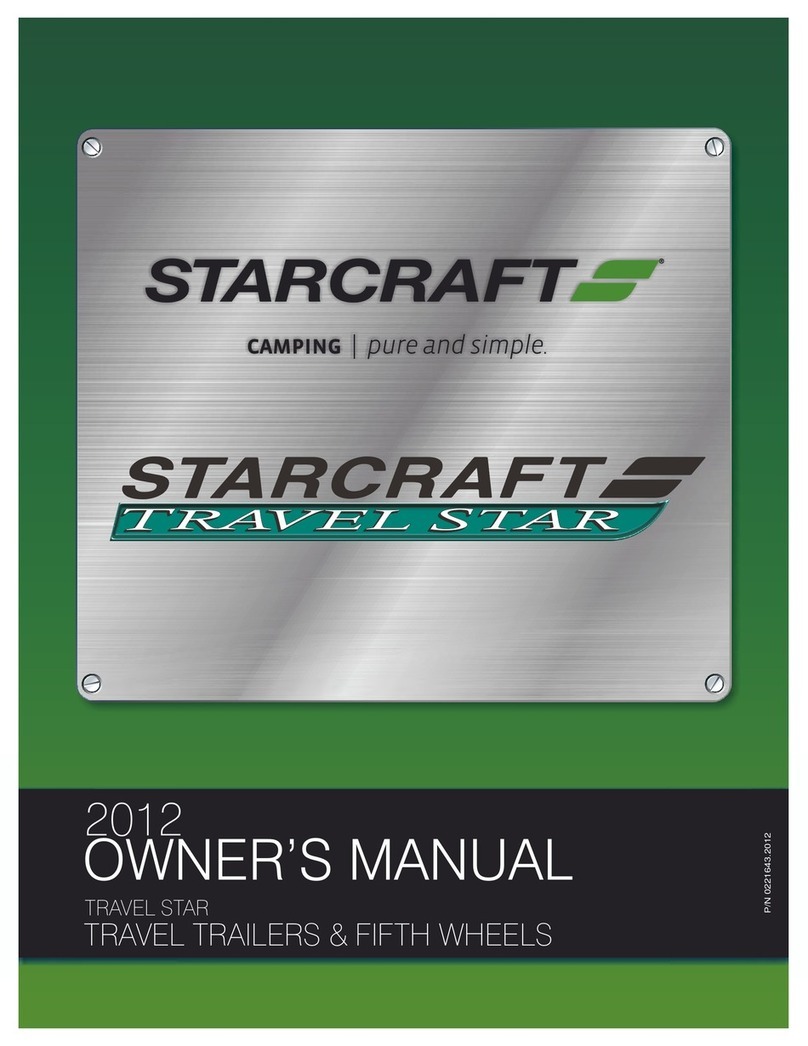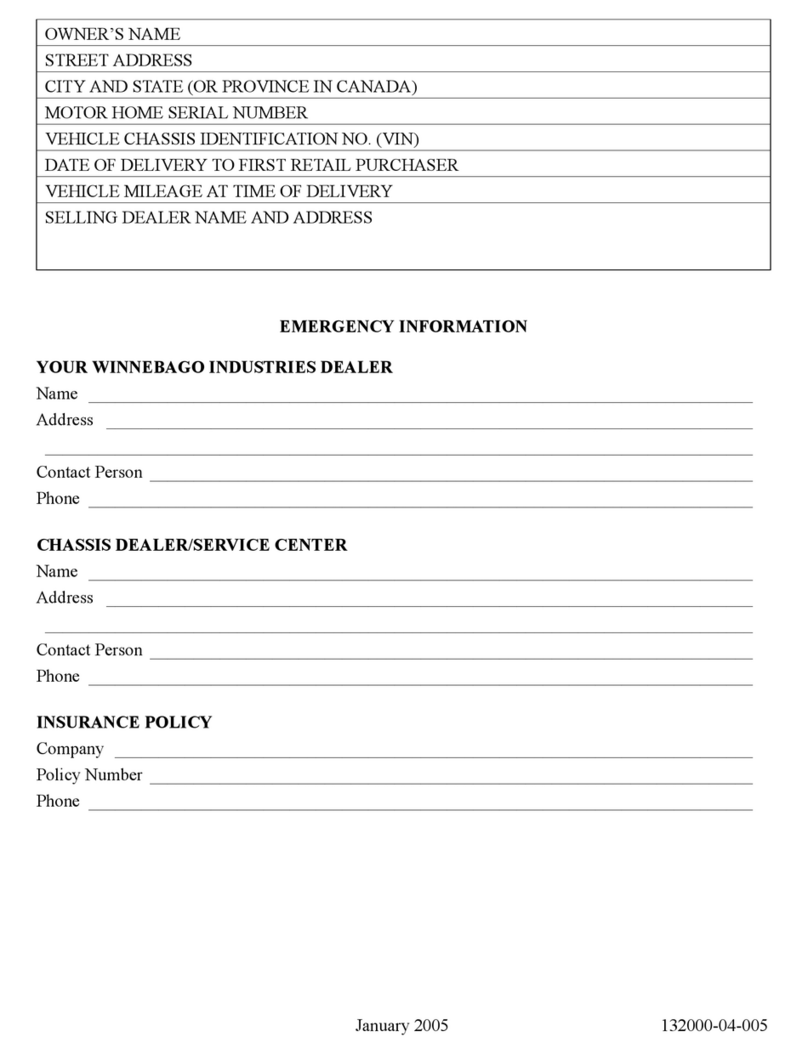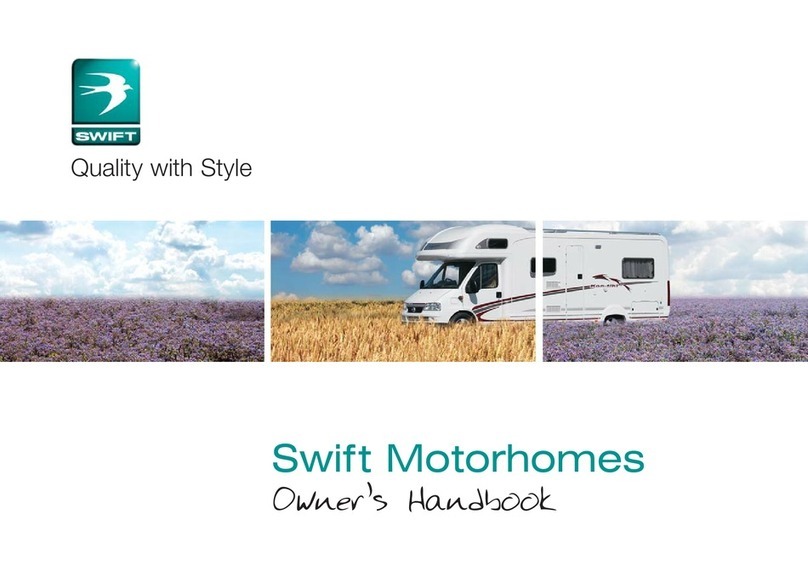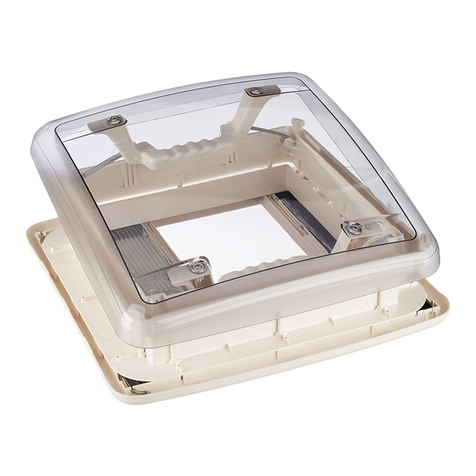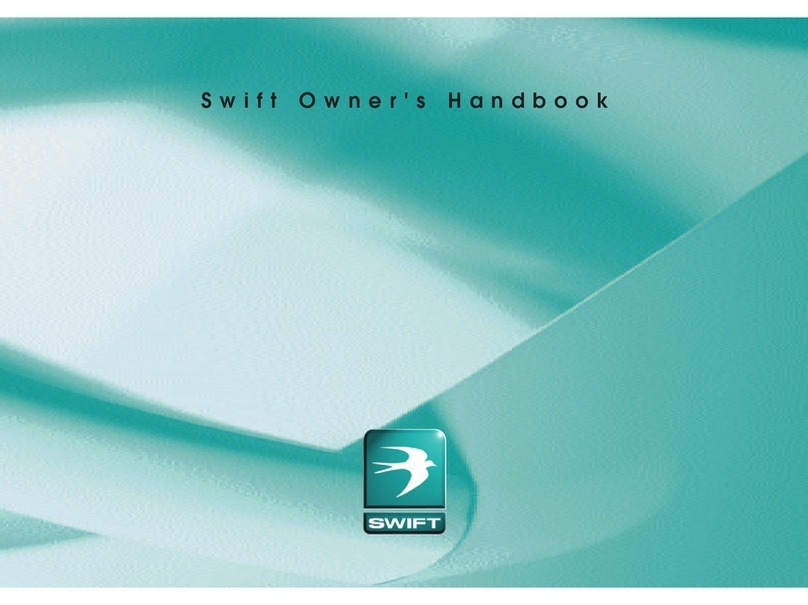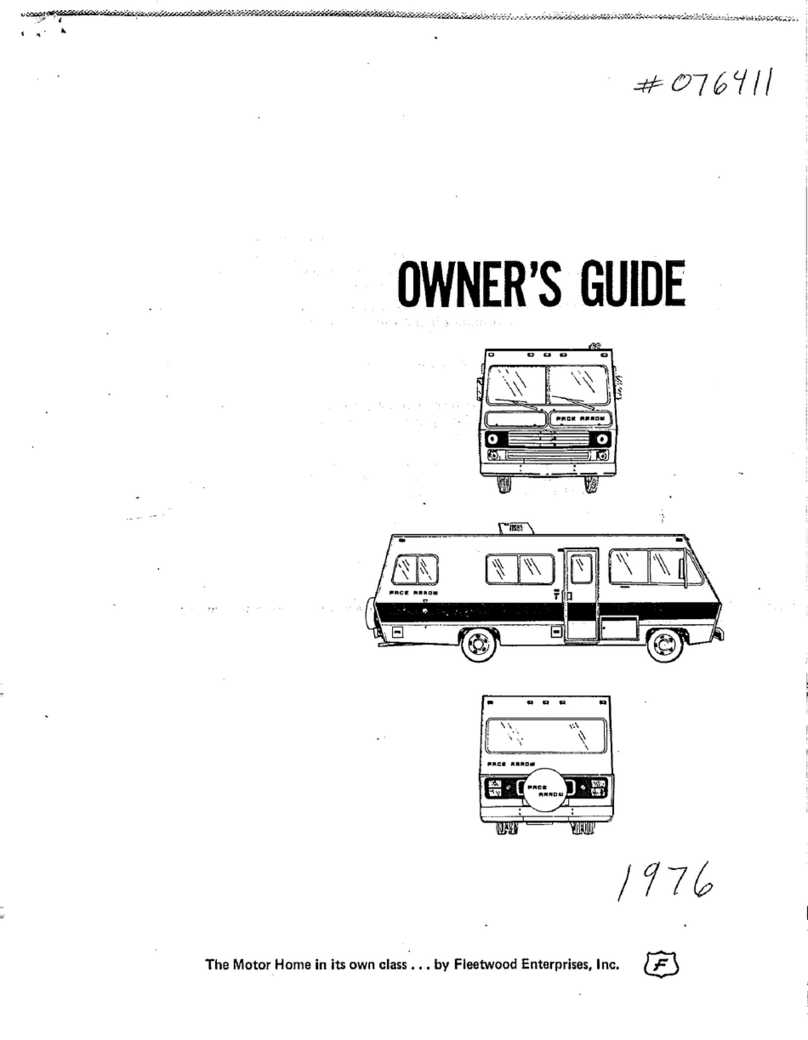FLEETWOOD RV Class A Gas 2020 User manual

fleetwoodrv.com
OWNER’S MANUAL
Class A Gas
2020
LASTING DEPENDABILITY | FAMILY FAVORITE | FEATURE PACKED
PART NUMBER: L90-0300-71

Owner Relations (800) 322-8216
Parts (800) 509-3417
FleetwoodRV.com
OUR VERY OWN FLEETWOOD RV
MOTORHOME SERVICE CENTERS
At Fleetwood RV, we strive to deliver peace-of-mind at every
turn. Our devotion to customer service starts with our trusted
dealer network and spans to our own staff of motorhome
service professionals at REV Recreation Group’s regional
technical centers. The motorhome service centers are
strategically located throughout the United States to provide
you convenient service wherever the road takes you.
Below, you’ll find the closest motorhome service center, as well
as a list of the other centers. Please visit www.fleetwoodrv.com/
motorhome-service-centers to schedule a Service Appointment.
East Coast REV Technical Center
800-509-3417
West Coast REV Technical Center
877-466-6226
RV Ownercare:
Limited one-year/15,000-mile coach warranty and three-year/45,000-mile structural warranty, whichever
occurs first, and it is fully transferable for the first 12 months. RV OWNERCARE is one of the RV industry’s most
comprehensive programs and includes systems, appliances, components and construction, with no deductible
and no service charge.
Chassis Warranty provided by Ford®

FLEETWOOD RV CLASS A GAS 2020 OWNER’S MANUAL 1
Owner’s Manual
CLASS A GAS 2020
Section One: General Information .............................3
Section Two: Limited One-Year Warranty ......................7
Section Three: Driving & Safety .............................. 13
Section Four: Exterior & Interior Care .........................57
Section Five: Appliances ....................................83
Section Six: Equipment.....................................104
Section Seven: Water Systems..............................126
Section Eight: Propane Systems.............................140
Section Nine: House Electrical .............................. 151
Section Ten: Maintenance Records .......................... 171
©2019 by REV Recreation Group, Inc. All rights reserved. No part of this publication may be reproduced or transmitted
in any form or by any means, electronic or mechanical, including photocopying, recording, or by any information
storage or retrieval system without written permission from REV Recreation Group, Inc.
IMPORTANT - PLEASE READ: Product information, photography and illustrations included in this manual were as
accurate as possible at the time of publication. Materials, design, and specifications are subject to change without
notice. Fleetwood RV has designed its recreational vehicles for a variety of customer uses. Each vehicle features
optimal seating, sleeping, storage, and fluid capacities. The user is responsible for selecting the proper combination of
loads (i.e. occupants, equipment, fluids, cargo, etc.) to ensure that the vehicle’s weight capacities are not exceeded.
Manufacturing brands of REV Recreation Group, Inc. include: American Coach, Fleetwood RV, and Holiday Rambler.
| PART NUMBER: L90-0300-71
7/18/2019

2
The information contained in this document is intended to reflect standard
and optional equipment included in a typically equipped model at the time
of delivery to the initial retail owner. Your actual unit may vary from this
document as a result of optional equipment that is not generally offered
on this model. In the case that you are not the initial retail owner of the
unit, this document will not reflect modifications that may have been
performed by previous owners.
©Copyright 2019 REV Recreation Group Inc. All rights reserved. All other
trademarks or registered trademarks are property of their respective
holders. Brand name products of other companies mentioned in this
manual are not endorsed by the manufacturer of the motorhome .
If you purchased this motorhome used, and are not the original owner
please go to: www.fleetwoodrv.com/change-of-ownership to update our
warranty information.
Product information and specifications are shown herein as of
the time of printing. The motorhome manufacturer reserves the
right to change product specifications, designs and standard
equipment without notice and without incurring obligation.

FLEETWOOD RV CLASS A GAS 2020 OWNER’S MANUAL 3
General Information
SECTION ONE
Warrenty Information File .................................4
Reporting Safety Defects..................................4
Safety Terms.............................................4
Glossary of Terms ........................................5
CALIFORNIA PROPOSITION 65 WARNING:
Most vehicles, including this one, contain and/or emit chemicals known to
the State of California to cause cancer and birth defects or other reproductive
harm. Engine exhaust and a wide variety of vehicle fluids, components, and
parts—including building materials used in the interior furnishings in this
vehicle—contain and/or emit these chemicals, including formaldehyde.
In addition, battery posts, terminals and related accessories contain lead
and lead compounds, chemicals known to the State of California to cause
cancer and reproductive harm. Wash hands after handling. Consult with
your doctor or other health professional for further advice concerning
exposure from this vehicle to chemicals known to the State of California to
cause cancer and reproductive harm.

4
General Information
SECTION ONE
WARRANTY INFORMATION FILE
In addition to this Owner’s Manual, a Warranty
Information File Box can be found in the motorhome.
This box contains valuable documents about the
motorhome’s systems and equipment. Many of the
component manufacturer warranty registration cards
can be found in the box. They will need to be filled
out and mailed. Carefully reading and understanding
of all the information in this box will help in the safe
operation, maintenance and troubleshooting of the
systems and equipment.
REPORTING SAFETY DEFECTS
If you believe that your motorhome has a defect which
could cause a crash or could cause injury or death,
you should immediately inform the National Highway
Traffic Safety Administration (NHTSA) in addition to
notifying REV Recreation Group Inc. at: 1-800-322-
8216.
If NHTSA receives similar complaints, it may open an
investigation, and if it finds that a safety defect exists
in a group of vehicles, it may order a recall or remedy
campaign. However, NHTSA cannot become involved
in individual problems between you, your dealer or REV
Recreation Group Inc.
To contact NHTSA, you may call the Vehicle Safety
Hot line toll-free at 1-888-327-4236 (TTY: 1-800-424-
9153); go to www.safercar.gov; or write to: Administrator,
NHTSA, 1200 New Jersey Avenue, SE, Washington,
DC, 20590. You can also obtain other information
about motor vehicle safety from www.safercar.gov.
CANADIAN CONSUMERS:
If you believe that your vehicle has a defect that could
cause a crash, injury, or death, you should immediately
inform REV Recreation Group at: 1-800-322-8216
or you may call Transport Canada toll-free at:
1-800-333-0510.
SAFETY TERMS
Many of the safety terms are personal safety
instructions. Definitions for the terms are listed below.
It is important to thoroughly read and understand the
safety instructions displayed throughout the manual.
Failure to comply with specific instructions may result
in personal injury or death. Many instructions are
required by National Safety Associations.
CAUTION: Cautions pertain to potential damage to
the motorhome and/or its components.
POISON: A warning or caution pertaining to safety and/
or use of a poisonous substance or harmful chemical.
NOTE: Information and reminders concerning proper
operation of the motorhome and/or its components.
WARNING: Warnings contain information regarding
personal safety and/or pertaining to potential
extensive or permanent damage to the motorhome or
its components by means of hazards or improper use.
INSPECTION: Inspection of the motorhome and/or its
components is required. Additional instruction may
follow.
LUBE: Lubrication, or addition of a lubricant product, to
the motorhome and/or a specified component or part
is required. Additional instruction may follow.
ASSEMBLE or REPAIR: Assembly, disassembly or
installation of a component or part, and/or repair to the
motorhome may be required. Assistance of Technical
Support or Technician may be necessary.
INFORMATION: References to additional information
regarding operation of the motorhome and/or its
components found in additional sources, other than
the Owner’s Manual. Also refers to the Warranty
Information File, found within the Warranty Information
Box in the motorhome.
TIP: Tips contain information, helpful hints and/or
suggestion for ease of operation of the motorhome or
its components.

FLEETWOOD RV CLASS A GAS 2020 OWNER’S MANUAL 5
GLOSSARY OF TERMS
AC Electricity: Alternating current also known as
household power.
Air Compressor: Pumps air to and builds air pressure
in an air system.
Air Dryer: Cools, filters and dries the air delivered by
an air compressor.
Air Governor: Controls the operation of the air
compressor by constantly monitoring air pressure
in the supply tank of the air system. The air governor
initiates the unload cycle when the cut-out pressure is
reached.
Alternating Current (AC): A current that oscillates at
a specified frequency typically 60 times a second (60
Hz) in the United States and Canada. Also referred
to as shore power, utility power, inverter power (if
equipped), generator power, or house power.
Ampere (Amp): The measure of electron flow rate
(current) through a circuit.
Ampere-hour (Amp-hr. AH): A unit of measure
for a battery electrical storage capacity, obtained
by multiplying the current in amperes by the time in
hours of discharge. Example: A battery which delivers
5 amperes for 20 hours, delivers 5 amperes times 20
hours, or 100 Amp-Hr. of capacity.
ANSI: American National Standards Institute.
ASTM: American Society for Testing and Materials.
Black Water: Term associated with the sewage holding
tank. The toilet drains directly into this tank.
CCA or Cold Cranking Amperage: The amount of
current a battery can deliver for 30 seconds at 0° F
without dropping below a specified voltage, usually
10.5 Volts DC.
Chassis Battery: Battery used to power the 12 Volt
accessories and start the engine.
Circuit: An electric circuit is the path of an electric current.
A closed circuit has a complete path. An open circuit has
a broken or disconnected path.
City Water: A term associated with the water supply
at campgrounds. It is called city water because water is
pulled from a central source (like in a city) and not the
fresh water tank.
Compressor Load Cycle: The time during which the air
compressor is building air pressure in an air system.
Compressor Unload Cycle: The time during which the
air compressor is idling and is not building air pressure
in an air system.
Curbside: This refers to the side of the motorhome that
faces the curb when it is parked. Often called the door
side or the passenger side.
Current: The rate of flow of electricity or the movement
rate of electrons along a conductor. It is comparable to the
flow of a stream of water. The unit of measure for current
is the ampere.
Cut-In Pressure: The pressure level in the air system
supply tank that triggers the compressor load cycle.
Cut-Out Pressure: The pressure level in the air system
supply tank which triggers the compressor unload
cycle.
Cycle: A battery discharge and subsequent recharge
equals one cycle.
Desiccant: A granular substance that has a high affinity
for water and is used to retain moisture from the air
stream flowing through the air dryer cartridge.
DC Electricity: Direct current also known as battery
power.
Direct Current (DC): Type of current that travels in one
direction. This type of current can be stored in a battery
bank.
Drain Trap: This is a curve that is in all drains. Water is
trapped in the curve and this creates a barrier so tank
odors cannot escape through the drain. Also called a
“P-Trap.”
Dry Camping: Camping in the motorhome when
there is no city water hook-up or shore power. In other
words, using only the water and power that is in the
motorhome and not from another source.
Drying Cycle: The time during which the air dryer cools,
filters and removes moisture from the air delivered by
the air compressor. The drying cycle begins and ends
the same as the compressor load cycle.

6
General Information
SECTION ONE
Dump Station: A site where the waste (grey) and
sewage (black) tanks can be drained. In most states it
is illegal to drain waste tanks anywhere other than at a
dump station.
Dump Valve: Another name for the T-handle valve
used to drain the sewage (black) and waste (grey)
tanks.
Escape (Egress) Window: The formal name for the
emergency exit window located in the motorhome.
Egress windows are identified by their red handles.
Full Hook-Up Site: A campground that has city water,
shore power and sewer hook-ups or connections
available.
Grey Water: Term associated with the waste water
holding tank. Water from the sink drains, the shower
and the washer-dryer (if equipped) go into this tank.
House Battery: Powers 12 Volt DC lights and
accessories inside motorhome.
HVAC: Heating, Ventilation and Air Conditioning.
LED (Light Emitting Diode): Indicator light.
Liquid Lead Acid Battery (LLA): A type of battery
that uses liquid as an electrolyte. This type of battery
requires periodic maintenance such as cleaning the
connections and checking the electrolyte level.
Low Point Drain: The lowest point in the plumbing.
Drains are placed here so water will drain out of the
lower end of the motorhome. Drains must be closed
when the water tank is filled.
OEM: Term for Original Equipment Manufacturer.
OHM: A unit for measuring electrical resistances.
Ohm’s Law: Expresses the relationship between Volt
(E), amperes (I) in an electrical circuit with resistance
(R). It can be expressed as follows: I = V/R or V = I*R.
If any two of the three values are known, the third value
can be calculated by using the above formula.
Potable Water: Water that is safe for human
consumption.
Potentiometer: A device for measuring an unknown
potential difference or electromotive force.
Pounds Per Square Inch Gauge (psig): Pressure
measured with respect to that of the atmosphere.
This is a pressure gauge reading in which the gauge is
adjusted to read zero at the surrounding atmospheric
pressure. It is commonly called gauge pressure.
Purge: The initial blast of air (decompression) from
the air dryer purge valve at the beginning of the air
compressor.
Purge Cycle: The time during which he air dryer is
undergoing purge and regeneration. This cycle starts
at the beginning of the compressor unload cycle
and normally ends well before the beginning of the
compressor load cycle.
Regeneration: The reverse flow of air through the air
dryer and out the purge valve that begins immediately
after the purge and lasts normally 10 to 15 seconds.
This reverse flow of air, from the air system and
through the air dryer, removes moisture from the
desiccant cartridge and prepares the air dryer for the
next compressor load cycle.
Roadside: The side of the motorhome that faces the
road while parked. Often called the off-door side or the
driver side.
SCA: Term for Supplemental Coolant Additive.
Chemical added to coolant for diesel engines to help
prevent cylinder liner pitting and internal corrosion.
Shore Cord: The electrical cord that connects the
motorhome to AC electrical supply.
Stinger: An arm attachment on a tow truck that is used
to lift the motorhome slightly for towing.
Volt: The unit of measure for electric potential.
Watt: The unit for measuring electrical power, i.e. the
rate of doing work, in moving electrons by or against an
electric potential.
Wet Cell Battery: A type of battery that uses liquid as
an electrolyte. This type of battery requires periodic
maintenance to clean the connections and check the
electrolyte level.

FLEETWOOD RV CLASS A GAS 2020 OWNER’S MANUAL 7
Limited One-Year Warranty
SECTION TWO
Coverage Provided........................................8
What Is Not Covered By This Warranty .....................8
Limitations ..............................................9
Your Rights Under State Law ..............................9
Legal Remedies and Dispute Resolution ....................9
Dealer’s Obligations .....................................10
Owner’s Responsibility...................................10
Warranty Service Procedures .............................10
Notification................................................................11
Service ....................................................................11
Unsatisfactory Service ......................................................11
Change of Ownership .....................................................12
Original Manufacturer’s Contact Information .............. 12
Chassis Assistance........................................................12
Reporting Safety Defects................................................... 12
Canadian Consumers......................................................12
For Motorhomes Manufactured By REV Recreation Group, Inc.,
sold in the United States and Canada

8
Limited One-Year Warranty
SECTION TWO
COVERAGE PROVIDED
This warranty covers vehicles manufactured by REV
Recreation Group and sold in the United States and
Canada. Your new motorhome is warranted under
normal use to be free from manufacturing defects
in material or workmanship when first sold by an
authorized REV Recreation Group Dealership. For
purposes of this warranty, “defect” means a failure
of the material or workmanship to conform to the
manufacturer’s specifications and tolerances.
This warranty covers the first retail purchaser and all
authorized transferee’s during the warranty period. The
warranty begins on the date of original retail delivery/
sale or the date the motorhome is first placed into
service as a rental, commercial or demonstrator unit
(whichever occurs first) the “Start Date” and extends
for the following periods:
1. For non-structural defects, one (1) year from the
Start Date or until the motorhome reaches 15,000
total miles as determined by the mileage shown on
the odometer, whichever occurs first ANY ACTION
FOR BREACH OF THIS LIMITED WARRANTY
MUST BE COMMENCED NO MORE THAN
NINETY (90) DAYS AFTER THE EXPIRATION OF
THE RELEVANT PERIOD.
2. For structural defects, three (3) years from the
Start Date or until the motorhome reaches 45,000
total miles as determined by the mileage shown
on the odometer, whichever occurs first. Structural
defects are defined only as the motorhome’s roof
structure, sub-floor structure, and Vacubond®
walls. ANY ACTION FOR BREACH OF THIS
LIMITED WARRANTY MUST BE COMMENCED
NO MORE THAN NINETY (90) DAYS AFTER THE
EXPIRATION OF THE RELEVANT PERIOD.
Unless prohibited by law, repairs or replacements do
not extend the time when you must commence an
action for breach of warranty and shall not extend the
warranty coverage period.
WHAT IS NOT COVERED
BY THIS WARRANTY
This warranty does not cover:
1. The automotive chassis system (including the
chassis and drive train), tires and batteries, all of
which are covered by the separate warranties of the
respective manufacturers of these components.
2. Components, systems, appliances or parts expressly
warranted by their respective manufacturer.
3. Defects or performance failures caused by or
related to:
a. Abuse, misuse, negligence or accident;
b. Failure to comply with instructions contained
in the Owner’s Information Warranty Packet or
failure to perform other routine maintenance;
c. Alteration or modification of the motorhome;
d. Environmental conditions (salt, hail, chemicals
in the atmosphere, etc.);
e. Normal deterioration due to wear or exposure,
such as sealants, fading or discoloration of
exterior surfaces or fiberglass, or soft goods,
such as fabrics, drapes, upholstery, screen,
cushions, mattresses and carpet wear;
f. Motorhomes on which the odometer reading
has been altered;
g. Normal maintenance and service items, such
as light bulbs, fuses, sealants, lubricants, etc.;
h. Appearance imperfections, dulling, yellowing,
chalking, flaking, peeling or fading of paint,
defacing, dents, scratches, chips on any
surface or fabric, graphics, exterior materials,
or upholstery that may have occurred prior
to delivery and are normally corrected
during the delivery inspection process at the
manufacturing plant or at the dealership;
i. The cost of transportation in connection with
warranty claims, including but not limited
to reimbursement for mileage or expenses
incurred traveling to or from such repair or
replacement location;

FLEETWOOD RV CLASS A GAS 2020 OWNER’S MANUAL 9
j. REV Recreation Group SHALL NOT BE
LIABLE FOR ANY (1) INCIDENTAL OR
CONSEQUENTIAL DAMAGES, INCLUDING
BUT NOT LIMITED TO ANY CLAIMS FOR
PROPERTY DAMAGE, LOSS OF USE, LOSS OF
VALUE, LOSS OF INCOME, LOSS OF TIME,
INCONVENIENCE, COMMERCIAL LOSS, BUS
FARES, VEHICLE RENTAL, FUEL, INCIDENTAL
CHARGES SUCH AS TELEPHONE CALLS OR
HOTEL BILLS, (2) ANY OTHER PROPERTY
DAMAGE CAUSED OR ALLEGED TO BE
CAUSED BY MOLD, CONDENSATION OR
MOISTURE, MILDEW, RUST, FUNGUS, DRY
ROT OR ANY MICROBIAL MATTER, OR (3)
LEGAL FEES OR EXPENSES;
k. Premature deterioration and accelerated wear
and tear on motorhomes used for full-time
living accommodations;
l. Motorhomes used for commercial or business
purposes;
m. Motorhomes that are not originally sold by an
authorized REV Recreation Group dealership,
i.e., sold at auction, wholesale, repossession,
salvaged or sold in an otherwise distressed
condition;
n. Motorhomes sold or used outside of the United
States or Canada;
o. Items that are working as designed but that
you are unhappy with;
p. Service work performed by a dealer, which
is generally covered by dealer’s own service
warranty.
REV Recreation Group reserves the right to make
changes in design or improvements to its products
or parts without obligation to make or install such
changes in any previously built product.
Installations or modifications to the motorhome are
not covered by this warranty. Any other company that
assembles, installs, modifies or up-fits your motorhome
or any of the parts, components, systems or appliances
will be solely responsible for those goods or services.
Some states do not allow the exclusion or limitation
of incidental or consequential damages, so the above
limitation or exclusion may not apply to you.
LIMITATIONS
ANY IMPLIED WARRANTIES, INCLUDING, BUT
NOT LIMITED TO THE IMPLIED WARRANTIES
OF MERCHANTABILITY AND FITNESS FOR A
PARTICULAR PURPOSE, ARE LIMITED IN DURATION
TO THE DURATION OF THIS WRITTEN WARRANTY.
Some states do not allow restrictions on how long an
implied warranty lasts, so this limitation may not apply
to you.
The manufacturer is not responsible for any
undertaking, representation or warranty made by any
dealer or other person beyond those expressly set forth
in this warranty. There is no warranty of any kind made
by REV Recreation Group beyond the limited warranty
contained in this document.
YOUR RIGHTS UNDER STATE LAW
This warranty gives you specific legal rights and you
may also have other rights, which vary from state to
state.
LEGAL REMEDIES AND DISPUTE
RESOLUTION
Any claim or controversy arising out of or relating to this
limited warranty, or beach thereof, shall be settled by
arbitration administered by the American Arbitration
Association in Milwaukee, Wisconsin in accordance
with the Commercial Arbitration Rules of the American
Arbitration Association. The laws of the State of Indiana
shall be applied in any arbitration proceedings, without
regard to principles of conflict of law. Each party shall
bear its own costs, fees and expenses of arbitration.
The arbitrator(s) determination and the basis for that
determination shall be in writing and shall include an
explanation of the basis for the determination. The
determination of the arbitrator(s) shall be final and
binding and judgment upon such determination may be
entered in any court having jurisdiction. The arbitration
proceedings and arbitration award shall be maintained
by the parties as strictly confidential, except as
otherwise required by court order or as is necessary to
confirm, vacate, or enforce the award and for disclosure
in confidence to the parties’ respective attorneys, tax
advisors, or senior management personnel.

10
Limited One-Year Warranty
SECTION TWO
DEALER’S OBLIGATIONS
At the time of sale of your new recreation vehicle, your
dealer is expected to:
• Deliver your motorhome in the best condition
possible. Your vehicle must pass the dealer’s
detailed pre-delivery inspection, including all
systems tests. If the dealer identifies any issues
during the pre-delivery inspection, the dealer is
obligated to repair or replace any parts necessary
to correct the identified defects in material or
workmanship. As a part of the pre-delivery
inspection procedure, the dealer is responsible for
road-testing the motorhome, noting and correcting
any steering problems and setting correct tire
pressures before delivery. REV Recreation Group
will not be responsible for front end alignment after
this pre-delivery inspection has been performed.
• Provide orientation for use of the motorhome, its
systems, components, and operation.
• Make minor adjustments to your vehicle (such
as adjustments to the interior or exterior doors,
cabinet latches, TV antenna control, etc.) and
make those minor adjustments for a period of 90
days after delivery. Thereafter, such adjustments
are your responsibility as part of regular and proper
maintenance, unless the adjustment is required
as a direct result of repair or replacement of a
defective part that is covered under this warranty.
• Request that you read all warranty information and
explain any provision not clearly understood.
• Ensure that you receive your Owner’s Information
Warranty Packet. Your dealer can assist you in
completing the OEM warranty registration card
and locate any required component model or serial
numbers.
• Chassis registration will be completed by your
selling dealer at the time of purchase.
OWNER’S RESPONSIBILITY
It is important that you read and understand all
instructions and precautions before operating the
recreational vehicle. Even if you are an experienced
owner, we encourage you to thoroughly read this Owner’s
Information Warranty Packet. Familiarize yourself with
this limited warranty as there are components and
appliances that are excluded or warranted separately
by their individual manufacturer’s limited warranty.
As the owner, you are responsible for regular and
proper maintenance as described in the Owner’s
Information Warranty Packet. Regular and proper
maintenance will help prevent conditions arising from
neglect that are not covered by the limited warranty.
For example, dulling and fading of exterior paint can be
increased by prolonged exposure to extreme sunlight,
air pollutants, and excessive moisture. Regular
monthly washing and polishing of exterior surfaces
is the best insurance against surface deterioration
such as fading, yellowing, or chalking. It is your
responsibility and obligation to return your vehicle to
your dealer for repairs and services.
WARRANTY SERVICE PROCEDURES
To help ensure you receive the level of service you
expect and deserve, here are some suggestions we
would like to make.
If you need warranty service or warranty information,
please see the booklets and other documents included
in your Owner’s Information Warranty Packet. For
warranty service, you should return your motorhome
to the selling dealer. If that is not possible, you may
contact any other authorized REV Recreation Group
motorhome dealer. The REV Recreation Group Owner
Relations department can help you find a dealer in your
area. If you have any questions about the warranty
or what it does or does not cover, or need assistance
finding an authorized dealer, please contact REV
Recreation Group Owner Relations at the following
address or phone number:
REV Recreation Group
Owner Relations
P.O. Box 1007
Decatur, IN 46733
1-800-322-8216

FLEETWOOD RV CLASS A GAS 2020 OWNER’S MANUAL 11
NOTIFICATION
REV Recreation Group has empowered its dealers
to make warranty and repair decisions. To obtain
warranty service, you must (1) notify an authorized
dealer and send written notice to REV Recreation
Group within the applicable warranty period and (2)
within thirty (30) days of discovery of a defect in
material or workmanship. You will have up to thirty
(30) days after expiration of the warranty period to
notify an authorized dealer and REV Recreation Group
of a defect that occurred during the warranty period. If
you submit a claim after the expiration of the warranty
period, you will need to provide proof acceptable to
REV Recreation Group to demonstrate that the defect
occurred during the applicable warranty period.
The manufacturer’s written notice should be mailed to:
REV Recreation Group
Owner Relations
P.O. Box 1007
Decatur, IN 46733
SERVICE
If you are having warranty work performed, be sure you
have your vehicle information available to speed up your
service. Provide your dealer with a written list of the
motorhome problems or the specific repairs needed.
Keep a maintenance log of your vehicle’s service history
as this can be helpful when diagnosing and addressing
the current issue. If you had work done that is not in
your maintenance log, let the service advisor know. It is
important that you provide any vehicle repair history to the
dealer’s service personnel so they can better understand
the problem and assist you.
If you have a long list of service items that need attention
and you need your motorhome quickly, discuss the
situation with the service advisor, listing the items in
order of priority. This will help the service department
manage its time and will help get you back on the road
as quickly as possible. If required work is not covered
under the warranty, your dealer’s service department
can help you with getting the correct service.
UNSATISFACTORY SERVICE
Once the work is complete, inspect the service or repair
job when you pick up your vehicle. Notify the dealer’s
service personnel immediately of any dissatisfaction.
Discuss any warranty related problems directly with
the manager or owner of the dealership, giving them an
opportunity to help the service department resolve the
matter for you. We sincerely believe that your dealer
and the factory representative will be able to solve
any problem that might arise. If, for some reason, a
problem is not handled to your satisfaction, we are here
to help.
If the dealer is unwilling or unable to resolve the issue
in a timely manner, immediately notify REV Recreation
Group by sending written notice detailing any alleged
unrepaired defect, or any other dissatisfaction
experienced with the motorhome. Giving the
manufacturer this direct notice, and opportunity to
cure, enables the manufacturer to supplement prior
efforts by its authorized dealers so any ongoing problem
or dissatisfaction can be resolved or addressed. In
order to expedite the process when contacting us
regarding an issue, please include the brand name
and Unit Identification Number (U.I.N.) of your
motorhome. The U.I.N. is located on the identification
tag underneath the driver’s side window on the exterior
of your motorhome. Upon receipt of notice of a claim of
unsatisfactory service, a REV Recreation Group Service
Center will repair or replace any parts necessary to
correct defects in material or workmanship.
THE MANUFACTURER’S WRITTEN NOTICE
SHOULD BE MAILED TO:
REV Recreation Group
Owner Relations
P.O. Box 1007
Decatur, IN 46733
IF YOU WISH TO CALL FOR ASSISTANCE, PLEASE
USE THIS TOLL-FREE TELEPHONE NUMBER:
REV Recreation Group
Owner Relations
1-800-322-8216
OR CONTACT US ONLINE AT:
www.revgroup.com
There may be times when your motorhome will
need repairs or parts while you are on the road. If an
authorized repair facility is not available within 100
miles, you may use another facility. If your motorhome
is repaired by a non-authorized repair facility (non-
REV Recreation Group dealer), be sure to save receipts
and especially any parts that are replaced. These parts
will have to be returned to your selling dealer before
you can be reimbursed for their cost.

12
Limited One-Year Warranty
SECTION TWO
CHANGE OF OWNERSHIP
With more REV recreational vehicles than any other
manufacturer* on the road today, it is important to
us to stay connected with our new owners as well as
those who have purchased a used motorhome. At REV
Recreation Group, we are committed to offering you
unmatched motorhome support! Please complete and
submit the Change of Ownership Form, online or by
contacting REV Recreation Group Owner Relations at
800-322-8216.
Please complete the change of ownership as soon as
possible.
* Based on IHS Automotive, Polk Recreational Vehicles in Operation (RVIO)
as of 7/1/13.
ORIGINAL MANUFACTURER’S
CONTACT INFORMATION
If you have a problem with separately warranted
items, you should contact the original manufacturer
first in order to get the fastest response. Since they
made it, they know best how to fix it and can give
you the most efficient service. The materials in
your Owner’s Information Warranty Packet contain
warranty information and operating instructions
on the various appliances and components in your
motorhome. If you do not have operating instructions
for a particular appliance or component, contact your
dealer. Warranty registration cards for these items
should be filled out and mailed as soon as possible
after you take delivery of your motorhome. When
contacting any of the equipment manufacturers,
always have the model and serial numbers
available. Appliance identification numbers will be
found on tags or plates attached to the appliance.
CHASSIS ASSISTANCE
If you have a warranty or service concern about the
chassis portion of your motorhome, you may go
directly to an authorized chassis dealer for service. This
may save you time and effort as the chassis warranty is
administered by the chassis manufacturer.
FOR CHASSIS ASSISTANCE CONTACT:
Ford Chassis Assistance 1-800-444-3311
OTHER MANUFACTURER CONTACTS:
Allison 1-800-252-5283
Cummins/Onan 1-800-286-6467
Whirlpool 1-866-698-2538
REPORTING SAFETY DEFECTS
UNITED STATES CONSUMERS:
If you believe that your vehicle has an alleged defect
that could cause a crash, injury, or death, you should
immediately inform the National Highway Traffic
Safety Administration (NHTSA) in addition to notifying
REV Recreation Group Owner Relations at
1-800-322-8216.
If NHTSA receives similar complaints, it may open an
investigation, and if it finds that a safety defect exists
in a group of vehicles, it may order a recall and remedy
campaign.
To contact NHTSA, you may either call the Vehicle
Safety Hotline toll-free at 1-888-327-4236 (TTY:
1-800-424-9153); or go to www.safercar.gov or write
to:
Administrator
National Highway Traffic Safety Administration
1200 New Jersey Avenue, SE
Washington, DC 20590
You can also obtain other information about motor
vehicle safety from the Vehicle Safety Hotline.
CANADIAN CONSUMERS:
If you believe that your vehicle has an alleged defect
that could cause a crash, injury, or death, you should
immediately inform REV Recreation Group at: 1-800-
322-8216 and call Transport Canada toll-free at:
1-800-333-0510.

FLEETWOOD RV CLASS A GAS 2020 OWNER’S MANUAL 13
Driving & Safety
SECTION THREE
Driving & Safety......................................... 15
Inspections ............................................................... 15
Mirror Adjust ............................................................. 15
Safety Seat Belts .......................................................... 15
Child Passenger Safety.................................................... 16
Child Seat Tethers (if equipped) ............................................16
Driving Tips.............................................18
Adjust to Driving Conditions ...............................................18
Trip Preparation ........................................................... 21
Hitch ...................................................22
Using the Hitch Receiver ...................................................22
Towing Systems...........................................................23
Towed Vehicle Requirements ...............................................27
Tow Plug Connection ......................................................27
Rear Vision System (Optional)............................28
Backing Up A Motorhome ................................28
Set-up Procedures .......................................30
Dry Camping............................................ 31
Breaking Camp..........................................32
Emergency Roadside Procedures..........................33
In Case of Flat Tire ........................................................33
Dead Chassis Battery......................................................34
Towing Procedures ......................................35
Tires ...................................................36
Importance of Air Pressure.................................................36
Load Inflation Table........................................................37
Inspecting & Pressure .....................................................39
Air Pressure Checklist .....................................................39
Tire Vibration .............................................................40
Tire Rotation..............................................................40
Tire Replacement .........................................................40
Storage of Tires — Long Term ..............................................4 1

14
Driving & Safety
SECTION THREE
Wheel Mounting ........................................41
Weighing the Motorhome . . . . . . . . . . . . . . . . . . . . . . . . . . . . . . . . 42
Weight Terms.............................................................45
Tire Pressure..............................................................46
Scales....................................................................46
Four-Point Weighing.......................................................47
Dangers of Overloading....................................................49
Weight Record Sheet ......................................................49
Front End Alignment .....................................50
Manual Headlamp Aiming Procedure......................50
Smoke Detector ......................................... 51
Operation ................................................................ 51
Testing ................................................................... 51
Maintenance ............................................................. 51
Troubleshooting........................................................... 51
Carbon Monoxide Detector...............................52
Operation ................................................................53
Alarm ....................................................................53
Fire Extinguisher ........................................55
Maintenance .............................................................55
Escape (Egress) Window.................................56

FLEETWOOD RV CLASS A GAS 2020 OWNER’S MANUAL 15
DRIVING & SAFETY
Section Two contains information on driving tips,
emergency situations, towing, safety devices, weighing
the motorhome and tires.
INSPECTIONS
Differences between a passenger automobile and
a motorhome are significant. Be aware of these
differences when traveling. The key to safely operating
the motorhome is inspection and maintenance.
Problems on the road can result in lost time and
increased repair costs. Several states require a special
driver’s license endorsement and vehicle inspection
prior to registration. Traffic laws do vary between
states. Be aware of these varying state traffic laws.
Conduct a systematic detailed inspection prior to moving
the motorhome. Examine the condition of the motorhome
and the surrounding area. Look “high and low” when
walking around the motorhome.
The location of the driver’s seat is higher and farther
to the left than most vehicles causing a different
perspective of the roadway. Use the outside mirrors to
gauge the center of the road and to check conditions
behind the motorhome. The dashboard may include
more gauges and controls than are normally found in
passenger automobiles. Become familiar with these
gauges and their indications before starting out.
MIRROR ADJUST
Adjust the mirrors prior to starting out. Have an
assistant help to simplify the mirror adjustment
process.
Mirror Adjusting:
• Tools needed: Allen
wrench.
• Adjust the driver seat
to the travel position.
• To adjust the “head”
of the mirror, loosen
one of the Allen set
screws located below
the mirror head shown
as point A. Adjust the
head of the mirror to
obtain best view.
• Manually adjust the
bottom section of the
mirror.
• Tighten set screw(s)
once the proper view
is obtained.
• Repeat procedure for
passenger side mirror.
SAFETY SEAT BELTS
All occupants must be
furnished with and use seat belts while the motorhome
is moving. The driver’s seat, and all other seats designed
to carry passengers while the motorhome is in motion,
are equipped with safety seat belts. Do not occupy beds
or seats that are not equipped with a safety belt while
the motorhome is in motion. The driver’s seat must be
locked in the forward facing position while motorhome
is in motion. Seat belts are designed for individual use.
Do not use a seat belt for more than one person.
To fasten the seat belt, pull the belt out of the retractors and
insert the tab into the buckle; a click will sound when the
tab locks into the buckle. Seat belt lengths automatically
adjust to each occupants size and sitting position. Do not
route belts over armrest or under the arm.
NOTE:
The motorhome has electronic data recording
devices that may record information about
direction, road speed, engine speed, brake
application, steering attitude or other vehicle
operating data. Data recording devices can be
present in engines, transmissions, ABS (Antilock
Brake Systems) or other systems affiliated with
operation of the vehicle. Information from data
recording devices can be examined in case of an
accident. Contact the component manufacturer to
learn more about these devices.
MIRROR CONTROL
HEATER
ADJUSTMENT
080378c
Mirror Switch
TIP:
Use the mirror adjust
switch located on the
driver’s armrest to
fine tune view of the
top mirror.
031210m
A

16
Driving & Safety
SECTION THREE
CHILD PASSENGER SAFETY
Child restraint requirements are determined by age
and weight. According to NHTSA (National Highway
Traffic Safety Administration), there are four stages to
child restraint safety. Go to: https://www.nhtsa.gov/
equipment/car-seats-and-booster-seats
CHILD SEAT TETHERS (IF EQUIPPED)
Some child seat manufacturers recommend the use
of a top anchorage (tether) strap in addition to the lap
belt. Since a top anchorage (tether) strap can provide
additional security to a child seat, we recommend using
a tether whenever one is required or available.
The motorhome may be equipped with a child seat
top anchorage (tether) strap anchorage point in the
forward passenger seat location.
The anchorage
hardware, if available,
is located at the lower
rear of the passenger
or secondary seat.
A small metal
anchorage loop will
be present which
will allow the tether
strap hook to engage
(see Illustration 1).
To use, with the seat in position, drape the tether
strap over the seat back and down (see Illustration 2).
Attach the tether strap hook to the tether anchorage
point and tighten the strap according to the child seat
manufacturer’s instructions. Make sure the strap is
not twisted and that the forward facing seat is always
positioned upright and locked in the forward facing
position when the motor home is in motion.
The child safety seat can be positioned in two places:
the front passenger (co-pilot) seat and forward facing
permanently mounted booth dinette seat equipped
with safety belts.
WARNING:
Safety belts are supplied at affixed seating
positions. Do not occupy seats not equipped with
safety belts while the motorhome is in motion. Seat
belts must only be used on permanently mounted
seats. Do not use a single seat belt on more than
one person. Pilot and Co-pilot seats must be
locked in a forward facing position with seat belts
fastened while the motorhome is in motion. Do not
rotate the seat while in transit.
WARNING:
Refer to the manufacturer of the child seat for
installation guidelines. Adhere to all instructions,
cautions and warnings for proper securement of
the child safety seat or booster seat.
020355c
Illustration 2
Top
Attachment
Alternate
Attachment
NOTE:
The motorhome manufacturer is not the author of
Child Passenger Safety. The information provided
is reprinted from the National Highway Traffic
Safety Administration’s website. Visit NHTSA’s
website at www.nhtsa.gov for the most recent
and up to date information.
WARNING:
Individual states and Canadian provinces may
have laws that can exceed the requirements as
described in this section. It is the responsibility
of the owner to know and comply with the laws
in the state or province in which the motorhome
will travel.
NOTE:
Use of a safety or booster seat in the front seat
may be prohibited in some states and Canadian
provinces.
020355b
Illustration 1

FLEETWOOD RV CLASS A GAS 2020 OWNER’S MANUAL 17
WARNING:
Do not transport children unrestrained. Infants must be placed in approved safety seats — small children must be
restrained in child safety seats. Do not use a single seat belt on more than one child. Failure to comply with
these rules can lead to injury or death.
TIPS:
• Go to www.nhtsa.gov and choose “Child Safety Seat Information” from the menu or click on the child
passenger safety icon. The site includes child safety seat installation tips, product ratings, recalls and
other useful information.
• For more information about child safety seats, booster seats, inspection/fitting stations in your area,
seat belts, and other highway safety issues, call the DOT Vehicle Safety Hotline at: 1-888-327-4236.
• A certified child passenger safety technician can check your installation and answer questions. To find a
technician or an inspection station near you, go to www.nhtsa.gov, click on the child passenger safety icon,
and then click on the Fitting/Inspection Station link, or go to www.seatcheck.org.
Step 1:
For the best possible protection keep infants in the
back seat, in rear-facing child safety seats, as long
as possible up to the height or weight limit of the
particular seat. At a minimum, keep infants rear-
facing until a minimum of age 1 and at least 20
pounds.
Step 2:
When children outgrow their rear-facing seats (at a
minimum age 1 and at least 20 pounds) they should
ride in forward-facing child safety seats, in the back
seat, until they reach the upper weight or height limit
of the particular seat (usually around age 4 and 40
pounds).
Step 3:
Once children outgrow their forward-facing seats
(usually around age 4 and 40 pounds), they should
ride in booster seats, in the back seat, until the
vehicle seat belts fit properly. Seat belts fit properly
when the lap belt lays across the upper thighs and
the shoulder belt fits across the chest (usually at age
8 or when they are 4’, 9” tall).
Step 4:
When children outgrow their booster seats, (usually
at age 8 or when they are 4’9” tall) they can use the
adult seat belt in the back seat, if it fits properly (lap
belt lays across the upper thighs and the shoulder
belt fits across the chest). All children under age 13
should ride in the back seat.
020355
1
4 STEPS FOR KIDS
2 3 4
Rear-Facing Forward-Facing Booster Seat Belt

18
Driving & Safety
SECTION THREE
DRIVING TIPS
The motorhome is a
complex vehicle that
requires increased driving
awareness because
of its size and various
components. Turning radius
will be much wider than
that of a standard automobile due to increased length.
Pay close attention to the perimeter of the motorhome
including front, sides, rear, roof and undercarriage. Ensure
the surrounding area is clear of obstacles. Use the mirrors
to observe traffic conditions as well as the exterior
including tires, bay doors, blind spots, etc.
Use a push-pull method of steering, with both hands
parallel on the steering wheel. The motorhome is
considerably heavier than an automobile and has a
higher center of gravity. These factors will necessitate
advanced reaction time. Swerving and sharp cornering
performed high speeds could result in loss of control.
Keep size and weight of the motorhome in mind. Drive
with increased caution to avoid situations that might
require quick momentum changes. Increase reaction
time by paying attention to traffic and road conditions
12 to 15 seconds ahead.
The motorhome will travel safely and comfortably at
highway speed limits. However, it takes more time to
reach highway speed. When passing another vehicle,
allow extra time and space to complete the pass due to
increased length.
Manually shift to a lower gear when descending a long
hill. Begin the descent at a slow speed. Do not allow the
motorhome to gain momentum before trying to slow
down. Use the transmission and engine to help control
downhill speed and can extend the service life of the
brake lining. Distance required to stop the motorhome
is greater than an automobile. Practice stopping away
from traffic to get the feel of distance required to stop.
Note weight limits of bridges before crossing. Signs
should be posted at bridge entrances. Check posted
height of all overpasses and situations where overhead
clearance is limited. Keep in mind road surfaces may
be repaved or packed with snow; therefore, the actual
posted clearance would be less in such conditions.
Use the pilot seat controls to comfortably position
the seat. Stay seated and adjust the outside mirrors if
necessary to gain a clear line of vision down both sides
of the motorhome.
ADJUST TO DRIVING CONDITIONS
Adjusting to road, weather and terrain conditions is
necessary to keep the motorhome under control. Pay
attention to road signs that advise of local road hazards
and driving conditions. Do not operate the motorhome
when road, weather and terrain conditions seem
unsafe.
The cockpit, dash area and windshield are larger than
those found on passenger cars and trucks. Keep the
windshield clear of humidity in the form of water or ice.
Start the motorhome and turn on the dash defrost to
help remove moisture from inside the windshield. It
may be necessary to use a clean cloth to wipe away
moisture. Do not operate the motorhome if the
windshield is not clear.
Keep windshield wipers in good working order at all
times. Do not operate the motorhome when road,
weather and terrain conditions are considered unsafe.
Driving Cautions:
• Avoid getting too close to the shoulder of the road,
which may be too soft to support the weight of the
motorhome.
• Side spacing is best maintained by keeping the
motorhome centered in the driving lane.
• Driving lanes in work zones can be uneven,
congested and more narrow than usual.
• Be cautious of road debris that can damage the
undercarriage of the motorhome or become lodged
in the dual tires and cause damage to the tires,
wheel rims or tow vehicle.
• On back roads and single divided roads, tree
branches and shrubbery can protrude into
the roadway. Watch for low hanging branches
especially during inclement weather. Rain and
snow will cause branches to hang lower than usual.
• Keep in mind that posted speed signs are usually
passenger automobile rated. Be extra aware of
driving conditions and use the appropriate speed
for a motorhome when necessary, especially on
corners and mountain roads.
Table of contents
Other FLEETWOOD RV Motorhome manuals


